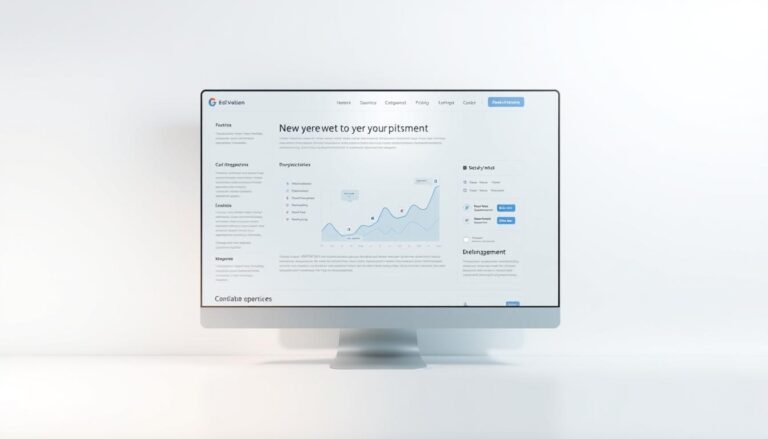In today’s sales world, competition is tough. To stand out, companies are trying new things to get better results. They’re using AI-driven lead generation, which uses artificial intelligence to find and help potential customers. This method not only makes things more efficient but also makes sure the leads are good and more tailored to people’s needs. As old ways start to lag in a fast-moving market, it’s crucial for companies to use these data-driven methods if they want to stay ahead.
Key Takeaways
- A comprehensive understanding of AI-driven lead generation can supercharge sales efforts.
- Artificial intelligence plays a crucial role in automating the lead acquisition process.
- Employing data-driven lead generation leads to improved lead quality and engagement.
- Companies that adapt to AI technologies are better positioned for market success.
- Continuous learning and adaptation are key components of successful AI integration in sales strategies.
Understanding AI-Driven Lead Generation
AI-driven lead generation is changing how we find and attract potential buyers. It’s about getting people interested in what you’re selling. Today, it’s key to use smart methods to stay ahead. Knowing how AI can help find and keep potential buyers is a big advantage in a competitive market.
What is Lead Generation?
Lead generation is a crucial early step in making sales. It’s about finding people who might buy something, learning about them, and making them interested in buying. Keeping a steady flow of these potential buyers is important for sales to keep growing.
How AI Transforms Lead Generation
Using AI lets us quickly look through lots of data to improve finding leads. AI looks at patterns and signs to pick out the best potential leads. This smart way of finding leads means businesses can focus on the most likely buyers. It makes the sales process faster by spending less time on leads that probably won’t buy.
Benefits of AI in the Sales Process
Using AI in sales has many benefits. It takes care of routine tasks, giving salespeople more time. Plus, it helps make messages to leads more personal. This helps businesses connect better with each potential buyer. With AI, sales teams have the tools they need to be more efficient and adapt to market changes quickly.
Technologies Powering AI-Driven Lead Generation
Many technologies fuel AI-driven lead generation today. They use data to make smart strategies that boost sales. This means companies can improve how they work and connect with customers better.
Machine Learning Applications
Machine learning has changed how we find leads. It looks at lots of data to spot trends and what customers do that we might miss. This helps make marketing better, leading to more sales.
Using machine learning helps businesses target leads more accurately. And it makes their sales efforts smoother.
Natural Language Processing
Natural Language Processing (NLP) lets computers understand and speak like humans. It’s key for better chats with customers using chatbots and automated replies. NLP makes sure replies to customers are both accurate and personal.
Adding NLP to AI lead generation helps keep conversations meaningful and strong.
Predictive Analytics in Sales
Predictive analytics is crucial for shaping sales plans. It uses math to guess how leads will act, helping companies know who might buy from them. By acting on these insights, businesses can focus on the right people.
This approach makes the sales process more efficient, using resources well for the best results.

Key Metrics for Measuring Success
When we look at how well ai-driven lead generation works, a few metrics really stand out. These are key to understanding if lead conversion and customer gaining strategies are doing well.
Conversion Rates
Conversion rates show us the share of leads that become paying customers. A high rate means the strategy is working well with potential clients. It shows the ai-driven tools are good at making sure leads are likely to buy. Tracking this helps companies spot what’s working and fix what isn’t.
Lead Quality Assessment
Finding out which leads are likely to buy is crucial. AI helps by looking at customer actions and data to find good prospects. This way, companies focus on quality over quantity, making customer finding more effective. Checking lead quality lets businesses focus on the most promising leads.
Customer Acquisition Cost
Customer acquisition cost (CAC) combines all costs of getting new customers, showing how spending efficiently. Using ai-driven lead generation can make finding customers cheaper. This highlights AI’s benefit as a smart investment, proving it can lead to better marketing results.
Targeting the Right Audience
Finding the right audience is key to getting leads. This starts with data analysis. Through this, businesses dig into customer information to find useful insights. They use advanced platforms to understand customer traits and habits that point to likely leads.
Utilizing Data Analytics
Data analytics gives businesses a strong structure for finding leads through data. By looking at consumer behavior trends, they learn a lot about potential customers. This helps make smart marketing decisions that truly match what customers are interested in.
Identifying Customer Segments
It’s critical to pinpoint different customer groups for effective marketing. Marketers divide their audience by traits like age, buying habits, and likes. Then, they customize their messages for these groups. this approach boosts engagement and the chances of making a sale.
Refining Targeting Strategies
It’s very important to keep improving how you target your audience for better marketing results. Looking at data regularly helps tweak the strategies to better reach leads. Making changes based on past interactions ensures marketing efforts hit the mark every time.
| Strategy | Description | Impact on Engagement |
|---|---|---|
| Data Analytics | Utilizing analytics to gain insights on customer behavior and preferences. | Increases relevance of marketing messages. |
| Customer Segmentation | Categorizing the audience based on specific traits for targeted messaging. | Enhances personalization and connection with different groups. |
| Targeting Refinement | Ongoing adjustments to campaigns based on data analysis results. | Improves overall campaign efficacy. |

Integrating AI with Existing CRM Systems
Mixing AI with current CRM systems is a big change in managing leads. It improves data use and helps build better relationships. Using AI strategies makes work easier. It gives companies a way to better understand and meet customer needs.
Benefits of Integration
Adding AI to CRM systems has many benefits:
- It makes data flow better, allowing for updates and access in real-time.
- It gives deeper insights into customer relationships, improving how businesses engage with customers.
- It boosts automation, cutting down on manual tasks.
Challenges to Consider
Yet, merging CRM systems with AI can be tricky:
- Issues with data compatibility across various systems can make integration tough.
- There’s a need for thorough training to make sure employees can use new features well.
- Staff might resist switching to AI-based methods.
Best Practices for Implementation
To get the most from integration, follow these tips:
- Look at your current workflows to spot where AI can add value.
- Pick tools that will work well with what you already have, making integration smoother.
- Make sure your team gets the training they need. This helps everyone adapt to the new tech faster.
Content Marketing and AI in Lead Generation
Combining AI with content marketing boosts engagement and conversion. Personalized content strategies let messages match the interests of leads. This approach uses data and insights to create content that matches audience preferences.
Personalized Content Strategies
Personalized content helps attract leads who feel important and seen. AI algorithms analyze user data to deliver relevant content for each person. This method enhances user experience and increases chances of conversion. Using AI insights for email campaigns or landing pages raises lead engagement.
Automating Content Distribution
Automation is key for timely content delivery. AI tools send content across channels at the perfect time, reaching leads when they’re likely to engage. This means consistent communication through social media, email, and ads. Automating content sends streamlines nurturing leads and boosts brand loyalty.
Measuring Content Effectiveness
It’s crucial to measure content marketing’s impact for strategy improvement. AI analytics show which content connects best with audiences. They help businesses adjust their content based on click-through rates and conversions. Using AI helps make decisions that match content efforts with lead-generation goals. For more on automated lead nurturing, see this detailed guide.
Ethical Considerations in AI Usage
The world of AI and lead generation is changing fast. It’s crucial we think about how this impacts ethics. Companies need to keep data private and make sure their AI tools are fair. This builds trust with customers, which is good for the business in the long run.
Data Privacy Concerns
Keeping customer data safe is a big deal when using AI. Businesses have to follow rules like GDPR and CCPA. They also need strong security to protect information from hackers. By doing this, companies show they care about using AI responsibly.
Avoiding Bias in AI Tools
It’s important to check AI algorithms for any unfair biases. Not doing this can harm certain groups, which isn’t right. By testing often and using data from many kinds of people, companies can keep things fair. This makes lead generation with AI better for everyone.
Transparency with Customers
Companies should be open about how they use data for AI. Telling customers how AI helps them can build trust. Keeping in touch with customers about this technology helps them feel connected to the brand. This way, using AI in a responsible manner meets what customers expect.
The Future of AI-Driven Lead Generation
The way we find and connect with customers is about to change, thanks to AI. With new tech, businesses can get to know their customers better and faster. This means companies can be smarter about who they talk to and how, making things more efficient all around.
Emerging Trends to Watch
Soon, we’ll see machines that understand what customers want as it happens. These smart systems will give people exactly what they’re looking for, using what they’ve liked before. It’s all about making shopping feel personal and easy, predicting what buyers need before they even ask.
Predictions for AI in Sales
Experts believe AI will become vital in finding the right people to sell to. It’ll sort through tons of info to highlight the best leads. This means sales teams can focus on people most likely to be interested, making their efforts more successful.
Preparing for Change in Lead Generation Strategies
For businesses to stay on top, learning about new tech is key. They’ll need to rethink how they get leads and train their people well. By staying up-to-date, businesses can tackle any challenge and find new ways to grow.
FAQ
What is AI-driven lead generation?
AI-driven lead generation uses artificial intelligence to find and attract sales leads better. It uses machine learning and other AI tools to make the process automatic and more efficient.
How does artificial intelligence enhance the lead generation process?
Artificial intelligence makes lead generation better by doing repetitive tasks automatically. It also studies buyer behavior and makes outreach more personal. This leads to more and better leads.
What technologies are essential for AI-driven lead generation?
Essential technologies include machine learning for analyzing data and natural language processing for clear communication. Predictive analytics is also important to predict how likely leads will become customers. These technologies make lead generation stronger.
What metrics should businesses monitor to measure the success of AI-driven lead generation?
Businesses should watch conversion rates to see how many leads become customers. They should also assess lead quality and check how much it costs to acquire new customers. These help in evaluating AI-driven processes’ success and ROI.
How can organizations effectively target the right audience using AI?
Organizations can use data analytics to look through customer data and find the right audiences. Analyzing potential leads’ behaviors helps tailor marketing messages for better results. This way, messages are more engaging.
What are the benefits of integrating AI with existing CRM systems?
Adding AI to CRM systems makes data flow smoother and gives deeper customer insights. It also boosts automation. This makes lead management much better.
How does content marketing integrate with AI for lead generation?
AI helps create personalized content strategies and ensures content reaches the audience at the right time. It also helps check if the strategy works and how to make it better.
What ethical considerations should businesses keep in mind when using AI for lead generation?
Businesses should think about data privacy and avoid bias in AI. They should also be clear with customers about how they use data. These steps make lead generation fair and secure.
What are some emerging trends in AI-driven lead generation?
Some new trends are better AI technology, improved predictive analytics, and analyzing customer data in real-time. Organizations should train their teams and update their strategies to stay ahead.



